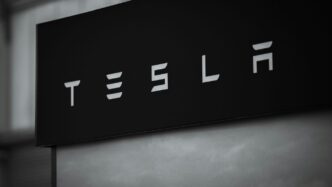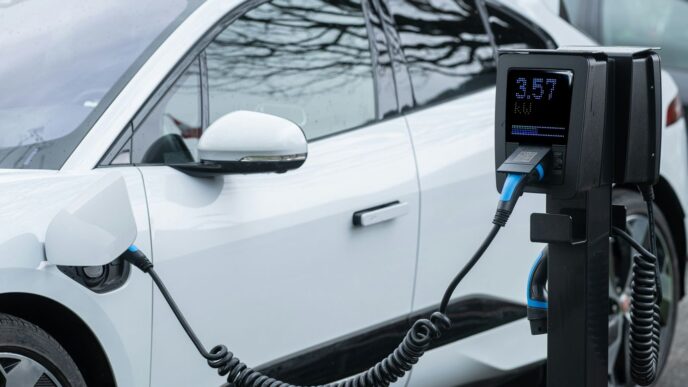Hey everyone, let’s talk about Tesla’s sales in the US. It’s been a wild ride, right? The company started out basically owning the electric car market, but things are getting a lot more crowded these days. We’re going to look at the numbers to see what’s really going on with Tesla US sales, how they’re doing compared to everyone else, and what might happen next. It’s not just about how many cars they sell, but also about how they’re selling them and what people think.
Key Takeaways
- Tesla US sales have seen a slowdown, with a noticeable drop in market share as more competitors enter the EV space.
- The Model Y continues to be Tesla’s strongest seller in the US, but its lead is shrinking.
- Older models like the Model S and X are facing challenges due to their aging designs compared to newer competitor vehicles.
- Customer satisfaction is being tested by issues like quality concerns, long service wait times, and unpredictable pricing.
- While Tesla still leads the EV market, its overall dominance is being challenged, making the future outlook for Tesla US sales more competitive.
Tesla US Sales Performance Over Time
Looking at how Tesla’s sales have changed in the US over the years gives us a pretty clear picture of their journey. It’s not just about selling more cars; it’s about how that growth has happened and what it means for their place in the market.
Annual Tesla US Sales Figures
Tesla’s annual sales in the United States have seen some big swings. After years of steady increases, we’re starting to see a different story unfold. The numbers show a company that once dominated the electric vehicle (EV) scene, but now faces a much more crowded field.
Here’s a look at the yearly sales:
| Year | Sales (Units) | Year-over-Year Change |
|---|---|---|
| 2020 | 442,562 | N/A |
| 2021 | 911,242 | +106% |
| 2022 | 1,247,146 | +37% |
| 2023 | 1,739,707 | +39% |
| 2024 | 1,704,093 | -2% |
As you can see, 2024 marked the first time Tesla’s US sales dropped year-over-year in quite a while. This dip, though small, is a sign of the changing market.
Quarterly Tesla US Sales Trends
When we break down sales by quarter, we can spot shorter-term patterns and understand the rhythm of Tesla’s business. These quarterly figures often reflect new model introductions, seasonal buying habits, or responses to market events.
Looking at recent quarters, the trend suggests continued pressure:
- Q1 2024: Saw a significant increase in sales compared to the previous year, showing strong early-year performance.
- Q2 2024: Continued to show positive year-over-year growth, though perhaps at a slower pace.
- Q3 2024: Sales remained strong, but the growth rate started to level off.
- Q4 2024: Experienced a slight decline compared to the previous year, indicating a shift.
- Q1 2025: Showed a notable year-over-year decrease, highlighting the ongoing challenges.
This quarterly view helps us see that the overall annual decline isn’t just a one-off event but part of a developing trend.
Tesla US Sales Growth Trajectory
Tesla’s growth trajectory in the US has been nothing short of remarkable, especially in the early to mid-2020s. They went from a niche player to a major force in the automotive industry. However, the recent data suggests this rapid growth phase might be slowing down, and the trajectory is flattening out, possibly even starting to curve downwards slightly.
Key points about their growth path:
- Early Dominance: Tesla enjoyed a period where they were almost the only game in town for EVs, leading to explosive growth.
- Market Maturation: As more automakers entered the EV space, Tesla’s share of the pie started to shrink, even as overall EV sales grew.
- Recent Slowdown: The past year or so has shown a leveling off, with some quarters even seeing declines.
The company’s overall US market share, which once seemed unstoppable, has been gradually decreasing. This doesn’t mean Tesla is failing, but it does mean their period of hyper-growth in the US market is facing new headwinds.
Market Share Dynamics for Tesla US Sales
Okay, so let’s talk about how Tesla is doing in the US market compared to everyone else. It’s no secret that Tesla used to pretty much own the electric vehicle (EV) space here. But things have changed, and it’s getting a lot more crowded out there.
Tesla’s Declining EV Market Share in the US
Remember when Tesla felt like the only EV game in town? Those days are definitely behind us. Back in 2020, Tesla held over 70% of the US EV market. By 2023, that number had dropped to about 55%. Now, looking at the data from early 2025, it’s fallen even further, hovering around 43-46%. By August 2025, it was down to just 38%. That’s a pretty big shift.
Here’s a quick look at how Tesla’s share of the EV market has changed:
- 2020: Over 70%
- 2023: Around 55%
- Early 2025: Approximately 43-46%
- August 2025: About 38%
This drop isn’t because Tesla is selling fewer cars overall (though that’s a different story we’ll get to). It’s because the whole EV market is growing, and a lot more players are jumping in with their own electric options. We’re talking over 50 different EV models from various car companies now. It’s a whole different ballgame.
Overall Vehicle Market Share for Tesla in the US
When you look at Tesla’s slice of the entire US auto market, not just EVs, the numbers are smaller but still tell a story. Tesla’s overall market share peaked at about 4.31% in 2023. By mid-2025, that had come down to around 3%. This shows that while Tesla is a major force in the EV world, it’s still a smaller part of the total car sales picture in the US.
Competitive Landscape Impacting Tesla US Sales
The competition is fierce, and it’s coming from everywhere. Legacy automakers like Ford and GM, along with newer EV companies like Rivian, are all rolling out compelling electric vehicles. These competitors are offering a wider range of styles, price points, and features, directly challenging Tesla’s previous dominance.
Here are some of the key factors making the competition tougher:
- More EV Models: As mentioned, there are now dozens of EV models available, from sedans and SUVs to trucks, giving consumers way more choices.
- Improved Technology: Competitors are catching up and, in some areas, even surpassing Tesla in terms of battery range, charging speed, and in-car tech.
- Established Brands: Traditional car brands have a long history and a large existing customer base, which they are now leveraging to sell their EVs.
- Price Wars: Increased competition has led to more aggressive pricing and incentives, putting pressure on all manufacturers, including Tesla.
The days of Tesla being the default choice for an electric car are over; consumers now have many excellent alternatives. This increased competition is definitely a major reason why Tesla’s market share, both in EVs and the overall market, has seen a decline.
Key Tesla Models Driving US Sales
When we look at the numbers, it’s pretty clear which cars are really moving off the lots for Tesla in the US. For a long time, it was a bit of a one-two punch, but things are shifting a little. Let’s break down what’s actually selling.
Model Y Dominance in US Sales
The Model Y crossover has been the absolute star for Tesla in the US for a while now. It’s like the Swiss Army knife of EVs – practical, good range, and fits the family needs for a lot of people. It consistently tops the charts, even as other automakers try to catch up. It’s the vehicle that really put Tesla in the mainstream for a lot of buyers.
Here’s a look at how the Model Y has been doing, alongside its sibling, the Model 3:
| Year | Model Y/3 Combined Sales (US Approx.) |
|---|---|
| 2021 | 200,000+ |
| 2022 | 250,000+ |
| 2023 | 300,000+ |
| 2024 | 280,000+ |
Note: These are combined figures for Model Y and Model 3, as Tesla often reports them together. Individual model breakdowns can be harder to pin down precisely from public data.
Model 3 Performance in the US Market
The Model 3 sedan was the car that really put Tesla on the map for mass-market appeal. It’s still a strong seller, but it’s definitely feeling the heat from newer competitors. Cars like the Hyundai Ioniq 6 and some of the BMW electric sedans are giving buyers more choices. While the Model 3 got a refresh, it’s facing a tougher crowd than it used to.
Contribution of Other Models to Tesla US Sales
Beyond the Y and 3, Tesla’s other vehicles play a smaller, but still important, role. The Model S and Model X, while older designs, still attract buyers looking for a more premium experience. They’ve seen some updates, but they aren’t volume drivers like the Y. Then there’s the Cybertruck, which finally started rolling out in late 2023. It’s definitely a head-turner and has a dedicated fanbase, but production is still ramping up, and it’s a niche product for now. The Semi truck is also in very limited production, mostly for commercial fleets.
So, while the Model Y is the clear leader, the sales picture is becoming more diverse as Tesla expands its lineup and the EV market matures.
Challenges Affecting Tesla US Sales
So, Tesla isn’t exactly the new kid on the block anymore, and with that comes some growing pains. It’s not like they’re the only game in town for electric cars these days, right? Other car companies have really stepped up their game, offering some pretty compelling alternatives. This increased competition is definitely making things tougher for Tesla.
Impact of Aging Product Lineup on US Sales
Let’s be real, some of Tesla’s models are starting to show their age. The Model S and Model X have been around for a while, and while they were revolutionary back in the day, their basic design is now over a decade old. Even though the Model 3 got a refresh in 2024 and the Model Y in 2025, competitors are rolling out completely new platforms. It makes you wonder if Tesla is keeping up.
Quality Concerns and Their Effect on Tesla US Sales
Then there are the quality issues. You still hear about panel gaps, paint problems, and interior materials that just don’t feel as premium as they should, especially for the price. Tesla consistently lands lower in initial quality studies, and these persistent complaints can’t be helping their reputation.
Service Infrastructure Strain on US Deliveries
Getting your Tesla fixed can also be a headache. Even though they’ve been expanding their service centers, it feels like they’re struggling to keep up with the sheer number of cars on the road. This often means long waits for appointments, which is frustrating for owners.
Price Volatility and Resale Value Concerns
Tesla has a habit of changing prices pretty frequently. This can be confusing for buyers and, honestly, it messes with the resale value of the cars. If you just bought a car and then see the price drop significantly a few months later, that’s got to sting. It makes people hesitant to buy, worrying they’ll lose money on their investment.
Future Outlook for Tesla US Sales

So, what’s next for Tesla in the US market? It’s a bit of a mixed bag, honestly. While the company has been a trailblazer, the landscape is changing fast. Tesla’s ability to adapt to a more crowded and competitive EV market will be key to its future success.
Anticipated Trends in Tesla US Sales
We’re seeing a few things shaping up. For starters, Tesla’s market share, while still significant, isn’t what it used to be. Competitors are really stepping up their game, offering more choices across different price points. This means Tesla can’t just rely on being the only major EV player anymore. Expect sales figures to be more influenced by how well Tesla’s current lineup stacks up against fresh designs from other automakers. Also, the whole electric vehicle tax credit situation is a bit of a moving target. The Inflation Reduction Act helped, but those credits are set to expire or change, which could definitely impact buyer decisions.
Impact of New Models on Future US Sales
This is where things could get interesting. Tesla has the Cybertruck now, which is definitely a unique vehicle, and they’re working on updating their existing models. The success of these newer or refreshed vehicles will be a big factor. Will the Cybertruck find a solid customer base beyond the initial hype? Can the updated Model 3 and Model Y hold their own against brand-new designs from rivals? We’ll have to wait and see how these roll out and if they can recapture some of the market momentum.
Regulatory Influences on Tesla US Sales
Government policies are always a big deal in the auto world, and EVs are no exception. Things like emissions standards and incentives play a role. For example, the federal tax credits for EVs have been a nice boost, but as mentioned, their availability and structure can change. State-level initiatives also matter. Plus, there’s always the possibility of new regulations around autonomous driving features or battery technology that could either help or hinder Tesla’s sales strategy. It’s a complex web, for sure.
What’s Next for Tesla in the US?
So, looking at all the numbers, it’s clear Tesla isn’t the only game in town anymore when it comes to electric cars in the US. Sales have dipped a bit, and other car companies are really stepping up their EV game. The Model Y is still a big seller, which is great for Tesla, but it’s not the runaway leader it used to be. It feels like Tesla’s facing some real competition now, with older models needing updates and some folks still talking about quality issues. It’ll be interesting to see how they handle things moving forward, especially with new models and more choices hitting the market all the time. They’ve got a strong brand, but the landscape has definitely changed.














